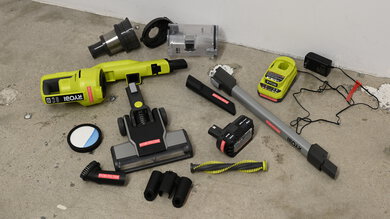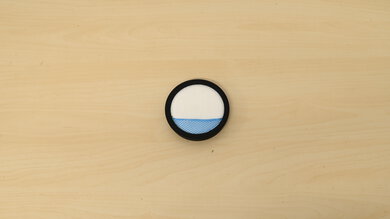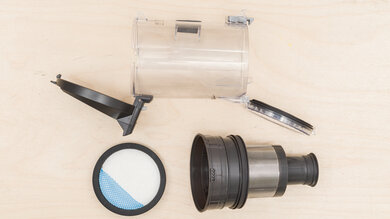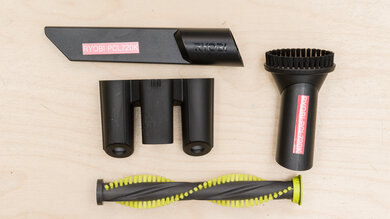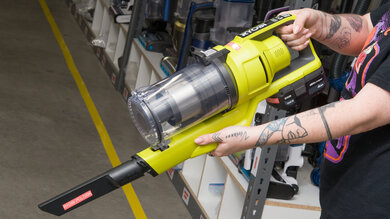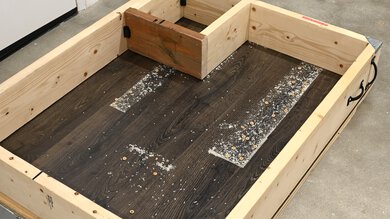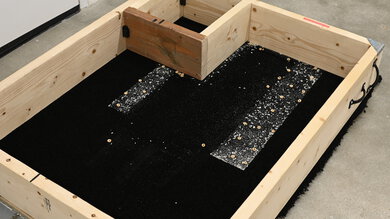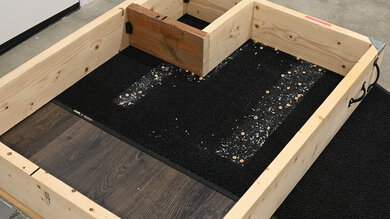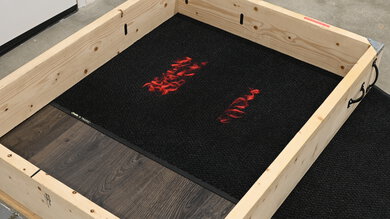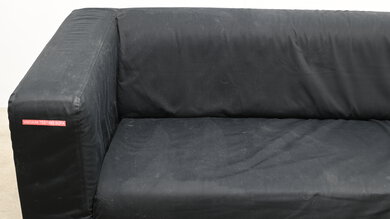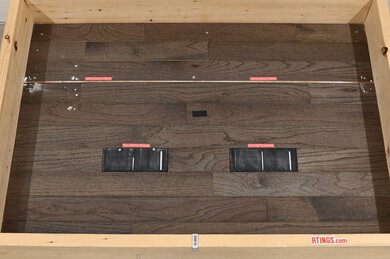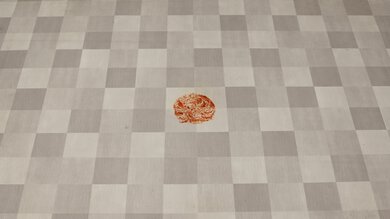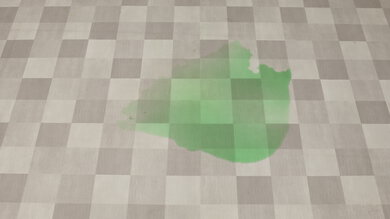The RYOBI PCL720K is a cordless stick vacuum. It's part of RYOBI's extensive ONE+ 18V system, a huge collection of products that includes drills, saws, fans, lights, as well as vacuums, all of which use interchangeable 18V battery packs. The PCL720K itself comes bundled with a 4Ah battery as well as a pair of accessories. In terms of features, it's also pretty spartan, with only two suction power settings and a brushroll off switch.
Our Verdict
The RYOBI PCL720K is okay for use on bare floors. Its performance on this floor type is only mediocre, but if you're willing to make a few more sweeps, it's got a lot going for it, too. It feels impressively robust, and it's also pretty easy to maintain. If you already have any other RYOBI ONE+ 18V tools at home with their own included batteries, you can also easily swap in a new pack for longer cleaning sessions. Despite being somewhat heavy for a stick vacuum, it's also impressively maneuverable.
-
Impressively well-built.
-
Great maneuverability.
-
Quick-change battery system.
-
Heavier than most other cordless stick vacuums.
-
Mediocre overall debris pickup performance.
The RYOBI PCL720K is a decent option for homes with a lot of low-pile carpeting. While it does a mediocre job of handling heavily embedded debris on this surface type, it does still feel quite nice to use, with a robust construction and easy-to-maneuver design. Its bristled roller also excels in clearing away pet hair on this surface type. Unlike a lot of other cordless stick vacuums, you can also quickly turn off that brushroll if it gets stuck on on obstruction, like rug tassels.
-
Impressively well-built.
-
Great maneuverability.
-
Quick-change battery system.
-
Heavier than most other cordless stick vacuums.
-
Mediocre overall debris pickup performance.
-
No floorhead height adjustment.
The RYOBI PCL720K is an alright choice for cleaning high-pile carpet. Its overall debris pickup performance on this surface type is far from special, with this vacuum having a particularly hard time with finer debris embedded deep within carpet fibers. Its floorhead also isn't height-adjustable, though you can turn off the brushroll to free it more easily if it gets bogged down on plushier carpets. Battery performance is quite good with the included 4Ah battery. If you have any other RYOBI ONE+ 18V tools lying around, you can also quickly swap in a new pack or use a higher-capacity unit for longer cleaning sessions.
-
Impressively well-built.
-
Great maneuverability.
-
Quick-change battery system.
-
Heavier than most other cordless stick vacuums.
-
Mediocre overall debris pickup performance.
-
No floorhead height adjustment.
The RYOBI PCL720K is an adequate option for pet owners. It does a great job of clearing away pet hair on floors, even on more challenging surfaces like low-pile carpeting, but it isn't bundled with a turbo brush or upholstery nozzle that would make it easier to clear away pet hair on furniture. It also does a terrible job of sealing in fine allergens like pet dander. It's pretty loud, which is far from ideal for easily startled pets.
-
Easily handles pet hair on floors.
-
Terrible particle filtration performance.
-
Not a wet-compatible vacuum.
The RYOBI PCL720K is very good for cleaning stairs. While it's a little heavy and cumbersome for a stick vacuum, it's ultimately still lighter than the majority of corded models on the market, and it isn't too much of an effort to pick up and carry. Its cordless design ensures you won't trip on a power cord while climbing or descending staircases. Unfortunately, if you detach the wand and use it as a handheld vacuum, it only comes with a crevice tool and a small dusting brush, neither of which are especially useful for stair cleaning.
-
Impressively well-built.
-
Heavier than most other cordless stick vacuums.
-
Small selection of included tools.
The RYOBI PCL720K is a decent option for cleaning the inside of your car. It can be easily reconfigured into a handheld vacuum for cleaning smaller spaces. Since it's cordless, you don't have to stay close to a power outlet, making it easy to reach every part of your car's interior. Unfortunately, the selection of included tools is a little limited, with only a crevice tool for cleaning tight corners and a soft-bristle dusting brush for vacuuming delicate, easily scratched plastic surfaces. A turbo brush tool is available for purchase separately, but while RYOBI does offer a flexible crevice tool as well, it's only available in a bundle with the two tools that are already included with the vacuum.
-
Impressively well-built.
-
Heavier than most other cordless stick vacuums.
-
Small selection of included tools.
The RYOBI PCL720K is a poor choice for workshop cleaning. It lacks the requisite power to deal with large amounts of heavy debris, and it isn't capable of sucking up liquid spills. Its dustbin is also pretty small and will need to be emptied pretty regularly. On the upside, it does feel quite robust and is easy to clean.
-
Impressively well-built.
-
Low suction at floorhead.
-
Not a wet-compatible vacuum.
- 6.9 Bare Floor
- 7.1 Low-Pile Carpet
- 6.7 High-Pile Carpet
- 6.8 Pets
- 7.9 Stairs
- 7.0 Cars
- 4.8 Workshop
Changelog
- Updated Oct 29, 2024: Review published.
- Updated Sep 25, 2024: Early access published.
- Updated Sep 23, 2024: Our testers have started testing this product.
- Updated Sep 18, 2024: The product has arrived in our lab, and our testers will start evaluating it soon.
- Updated Sep 12, 2024: We've purchased the product and are waiting for it to arrive in our lab.
Check Price
Differences Between Sizes And Variants
The RYOBI PCL720K is only available in a single colorway: 'Green.' For those interested, here's the product label. That said, two product bundles are available:
| Bundle | Included Tools and Accessories |
| Tool Only | Crevice Tool, Dust Brush, Wall Mount |
| Full Kit | 18V 4Ah Lithium Battery, Charger, Crevice Tool, Dust Brush, Wall Mount |
If you come across another variant of this vacuum, let us know in the discussions below so that we can update our review.
Popular Vacuums Comparisons
The RYOBI PCL720K is ultimately a pretty basic cordless stick vacuum. In terms of debris pickup performance and features, it lags behind comparably-priced alternatives like the Tineco PURE ONE S11. That said, it does still manage to feel better to use, with a far more robust construction, a smoothly articulating floorhead, and a quick-change battery system.
If you're looking for alternatives, see our list of recommendations for the recommendations for the best cordless stick vacuums, the best vacuums for hardwood floors, and the best lightweight vacuums.
The Dyson V8 is more well-rounded than the RYOBI 18V ONE+ PCL720K. The Dyson weighs considerably less, can be bundled with a much bigger assortment of tools and accessories, makes less noise while running, and delivers marginally better performance on carpeted floors. However, the RYOBI feels much more solidly built, and when used with a 4Ah battery, can run for more time on a charge while taking a lot less time to recharge.
As is to be expected with the significant price difference, the Dyson V15 Detect provides better overall performance than the RYOBI 18V ONE+ PCL720K. The Dyson has a much easier time clearing away debris on hard floors and carpeting and is loaded with features: its automatic power adjustment system not only responds to changes in surface type but also to the quantity of debris being sucked up. The V15 also has a higher-capacity dustbin and comes with more tools and accessories. All of that being said, the RYOBI feels like a far more solidly built product. While the Dyson can also run a little longer on a single charge, the RYOBI's included 4Ah battery pack takes a lot less time to recharge.
The Shark Stratos Cordless is a more feature-dense vacuum than the RYOBI 18V ONE+ PCL720K. The Shark's Clean Sense IQ system allows it to automatically adjust its suction power setting depending on how much debris is being sucked up, and its folding wand allows you to clean under tables and chairs without having to bend too deeply. The Shark is also more efficient in clearing away debris than the RYOBI. However, the RYOBI does feel more solidly built, and it does a better job of dealing with pet hair. The RYOBI's 4Ah battery also charges a lot faster while providing a comparable runtime to the Shark.
The Dyson V11 is ultimately a stronger performer than the RYOBI 18V ONE+ PCL720K. The Dyson delivers much better debris-pickup performance across a variety of surfaces, and it's packed with a wider array of features. Its surface detection system allows it to automatically change its suction power setting depending on the surface you're cleaning, and its multi-stage filtration system does a much better job of locking in particles compared to the RYOBI. The Dyson is also lighter and quieter and can be bundled with more tools. On the other hand, the RYOBI feels considerably more solidly built.
Test Results
The RYOBI PCL720K is impressively well-built. It's made mostly from thick, high-grade plastic that feels similar to a lot of other RYOBI tools, though it does have a metal pre-filter grille and rubber tires on its floorhead's wheels. It's far more robust-feeling than a lot of other conventional cordless stick vacuums on the market. Parts are attached to one another with heavy-duty latch mechanisms that exhibit minimal wobble or flex.
This vacuum is fairly easy to maintain. There are few parts that need regular cleaning, and they're simple to access for the most part. That said, you will have to put up with a few annoying quirks. You can't empty the dustbin without removing it, which can get pretty tedious considering how small it is and how often it needs to be emptied as a result.
While it takes a fair amount of hair to jam the brushroll, it's hard to remove any tangled strands by hand. You'll have a much easier time using a pair of scissors to cut away any hair stuck in the bristles.
Thankfully, the filter assembly is a cinch to clean - it comes out of the dustbin without much effort and can be rinsed under water to clear any stuck-on dirt.
If you'd like to see a deeper breakdown of the maintenance requirements involved for this vacuum, you can read the user manual online.
This vacuum incurs decently low recurring costs.
- Main filter: This vacuum's filter needs to be replaced every three to six months. A replacement can be purchased from RYOBI's online store.
This vacuum is pretty easy to store. It stands up on its own, with no need to set up a wall mount. There's also a wand clip that can hold both included attachments, so you won't have to set them aside in a separate bag.
The RYOBI PCL720K's dustbin is pretty small. It's comparable in size to a lot of older stick vacuums, like the Dyson V8, and as a result, it'll need to be emptied often, which requires you to detach the dustbin entirely. On the upside, there's a highly visible fill line to let you know when it's reached max capacity.
This is a cordless vacuum, so the range is limited only by remaining battery life and dust bin capacity.
The RYOBI PCL720K is pretty heavy for a stick vacuum, thanks in part to its thick plastic chassis. The standard 4Ah batter pack is also on the heavier side and can place a small amount of strain on your arm if you're really throwing the vacuum around while cleaning. On the upside, you can shave off a fair amount of weight by using a lower-capacity 2Ah battery pack, available in standard or high-performance varieties, though this will result in a shorter runtime.
Battery performance with the default 4Ah 18V lithium battery pack is good overall. The vacuum will run for up to an hour in its 'ECO' setting or just over 20 minutes in its default power setting. Broadly speaking, these numbers are in line with other cordless stick vacuums. If you're willing to put up with even more weight and have other RYOBI tools at home that require more power, you could also mount a higher capacity 18V RYOBI ONE+ battery, like a 6Ah or even 8Ah pack. It can be recharged with the provided charging dock.
This is a pretty simple stick vacuum. You can toggle between default and low-suction settings by pressing the 'ECO' button or turn the brushroll off, which is great for cleaning delicate surfaces like hardwood or vinyl, where you wouldn't want to create micro-scratches on your floors. The headlight on the floorhead also turns off automatically when the brushroll is turned off. This can be a minor nuisance when cleaning darker areas on hard flooring.
By default, this vacuum doesn't come with many tools. There's a crevice tool for cleaning cracks and a soft bristle dusting brush for cleaning delicate surfaces, along with a wand clip for holding both when not in use. There are optional extras, however. RYOBI also sells a floorhead with a secondary soft roller for hard floors as well as a mini turbo brush attachment for cleaning fabric furniture. There's also a micro-crevice tool for cleaning really tight spots, but it's only available as part of a 3-piece bundle, which already includes the default dusting brush and crevice tool.
Performance on hard floors is mediocre. Its brushroll scatters around larger debris but ultimately does improve overall debris pickup when it comes to smaller debris like rice or sand; we also tested the vacuum with the brushroll off and found its performance to be worse overall.
With the vacuum set to its default power setting, its performance on high-pile carpet is only passable. It's alright at dealing with medium-sized and large debris like rice or cereal on this surface type, though a second sweep might still be necessary. Unfortunately, it has a really hard time with finer material like sand.
This vacuum's suction power is pretty low. Not only is its peak suction power comparable to that of older, weaker stick vacuums like the Dyson V7, but its wide multi-surface floor nozzle diffuses that suction over a wide area. The end result is that the RYOBI will lack some oomph when it comes to dealing with debris embedded deep within cracks and crevices.
Airflow performance is also mediocre. The RYOBI PCL720K will have a hard time lifting away large amounts of heavy debris.
This is a pretty noisy vacuum even on its default power setting, though a lot of that noise comes from the brushroll mechanism. Turning it off drastically reduces operating noise:
- Bare Floor (Brushroll off)
- 'ECO' mode: 68.6 dBA
- Default mode: 74.5 dBA
- Carpet (Brushroll off)
- 'ECO' mode: 68.4 dBA
- Default mode: 75.5 dBA.
This vacuum is impressively maneuverable. Despite its relatively heavy weight, it actually isn't much of a hassle to use in cramped rooms. Its floorhead pivots smoothly and accurately, and its top-mounted dustbin allows you to clean with the wand completely to the floor, making it much easier to clean under tables and couches. You can also maneuver over thinner power cords without worrying about the vacuum getting stuck. It isn't all positive, however: even with the brushroll turned off and suction set to 'ECO,' the vacuum can still get stuck pretty easily on thick, shag-pile carpeting.
This vacuum does a mediocre job of clearing away pet hair on furniture. There's no upholstery nozzle included, which would make much shorter work of this kind of task, though you can buy a mini turbo brush. Its standard dusting brush is the right size for furniture cleaning, but unfortunately, it still tends to leave some hair behind, with some actually getting stuck to the tool's bristles. The side-mounted exhausts can also blow around lighter strands of hair. Its heavy 4Ah battery pack also makes the PCL720K cumbersome to use in a handheld configuration.
This vacuum does a terrible job of sealing in allergens, with fine particles being able to escape from its exhaust. As a matter of fact, the user manual recommends wearing a mask when cleaning particularly dusty areas.
Comments
RYOBI 18V ONE+ PCL720K: Main Discussion
Let us know why you want us to review the product here, or encourage others to vote for this product.
The full review has been posted here. Let us know what you think!
- 21010
Seconded. We are considering a second lightweight stick vacuum. The Ryobi is tempting as it allows for using interchangeable batteries from our other tools, but I don’t want to invest in it if it doesn’t stack up well against the other lightweight vacuum designs like the Samsung or the Wyze.
- 32120
Yes! Please review one of the Ryobi stick vacuums or one of the new releases



